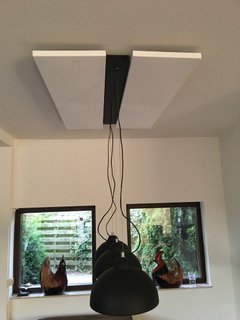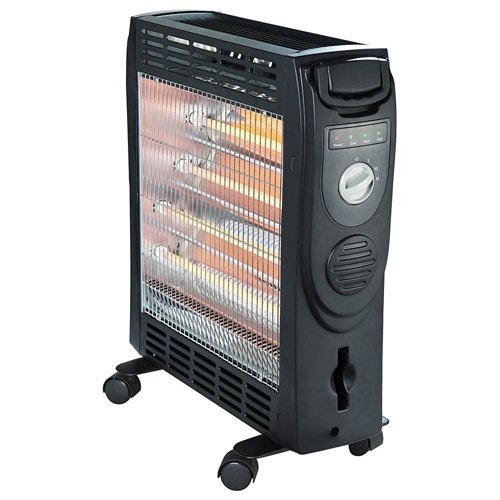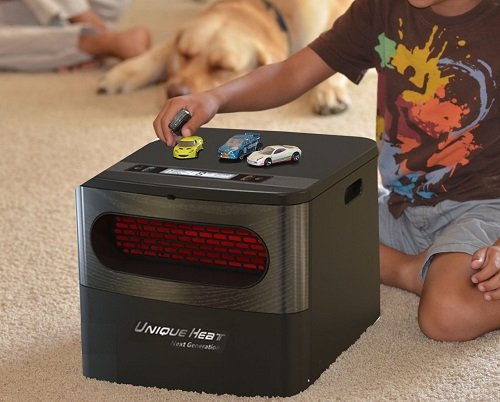Like every other heater, all energy input of an infrared heater is converted into heat. There are no losses because energy loss is always in the form of heat. And heat is exactly what a heater is trying to create. Therefore, the efficiency of all space heaters is always 100%. An infrared heater generally converts about 90% of its energy use into warm infrared radiation and 10% into warm air.
However, infrared heaters are more effective than other forms of heating because they heat directly with the use of radiation. In this way, they require less energy to create the same level of comfort.
Infrared heaters have an efficiency of 100%. They convert 90% of their energy use into infrared radiation and 10% into warm air. Infrared heaters require around 40 to 60 % less energy to create the same level of comfort as other heaters.
Infrared heaters are more effective than other heaters because they use infrared instead of warm air. They use 40 to 60% less energy to create the same level of comfort.
Infrared heaters work differently than other heaters
Infrared heaters produce infrared radiation. In this way, they create heat that feels similar to sun rays. This means that anyone or anything that is in sight of the heater is warmed by these wonderful infrared rays.
Conventional space heaters heat the air within the room. This is an ineffective and indirect way of heating because warm air rises to the ceiling or is easily lost by a draft.


Efficiency: infrared vs other forms of heating
Many vendors of infrared heaters mention that infrared is much more efficient than other forms of heating. I contacted some infrared heating companies and asked how efficient infrared heating actually is.
Infralia, a European vendor of infrared heaters, says that 600-watts of infrared is about as effective as 1500 watts of regular heating. This would mean that infrared heating is 60% more efficient than regular heating.
Herschell, a well-known producer of infrared heaters, also says that infrared heaters are up to 60% more energy efficient.
A third vendor, infraroodexpert, says infrared heating is about 40% more efficient. They also gave me an indication of the number of watts needed per room type. You can see the table below.
Comparing infrared and regular heating
Let’s compare the required wattage per square feet for regular heating as well as infrared heating.
For regular heating, the rule of thumb is you need approximately 10 watts per 1 square foot (0.1 m²). For infrared, this is much lower at 7 watts. The following table shows the required wattage per room for infrared heating as well as regular heating.
| Area | Infrared wattage per sq. ft (0,1 m²) | Regular wattage per sq. ft (0,1 m²) |
|---|---|---|
| Living room | 7 W | 10 W |
| Bedroom | 4.5 W | 6.3 W |
| Bathroom | 9.3 W | 13.3 W |
| Closed porch | 9.3 W | 13.3 W |
| Open outdoor area | 28 – 56 W | n.a. |
Why is infrared heating more efficient than regular heating?
As I mentioned above, all heaters are 100% efficient in turning their energy use into heat. However, it would be more accurate to look at what you actually want from your heater.
For example, a heater that produces warm air can be 100% efficient. But when you use it in a room with a very high ceiling or with very poor insulation, it wont be as effective in heating the room.
Therefore, I like to look at the effectiveness of the heater in accomplishing my goal. Here, infrared heaters become very interesting in certain situations. Especially when used as supplemental heating.
Since infrared heaters do not heat the air, but the objects and people in the room, people feel comfortable at relatively low air temperatures. Therefore, infrared heaters can make you feel comfortable quickly, without the need to warm up the whole room.

How to reach maximum efficiency
There are a few things you can do to improve the effectiveness of infrared heaters:
- correct placement of the heater
- good insulation of the heated room
- control humidity levels
Correct placement of the heater
Infrared heaters give off their heat just like the sun. So when you are in the shade, you do not feel the heat as much. Therefore, it is important to place the heater so that it is not blocked by any large object. Do not place furniture in front of the heater.
For infrared heating panels, arguably the best way of infrared heating, ceiling or wall mounting is easy. Ceiling mounted panels are generally not blocked by any objects and can therefore distribute their warming rays uninterrupted.
Other, portable, infrared heaters need to be placed in such a way that they are at least 3 feet (0.9 m) away from other objects.
Good insulation improves effectivity
As you know, poor insulation makes you lose a lot of warmth. With infrared heating, this is a little different. The air temperature can be a little lower because you are directly heated by the comfortable warm rays.
However, insulation is still quite important. Firstly to keep the air temperature at a reasonable level and prevent cold drafts. Secondly, because infrared also warms objects such as walls and doors. Which can give off their heat to the outside more easily with poor insulation.
Humidity levels are important for heater effectiveness
You might know from experience when traveling that a familiar air temperature can somehow feel much different than it does at home. This happens because of a difference in humidity.
When the air contains more water vapour (high humidity) it feels relatively warm. This happens because you cannot sweat as easily.
Therefore, humidity is an important factor for comfort at home. The preferred humidity levels are between 30 and 50 %.
With these levels of humidity, a space heater can perform at its best.

